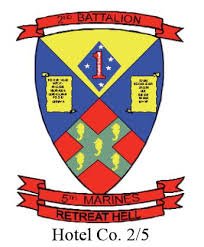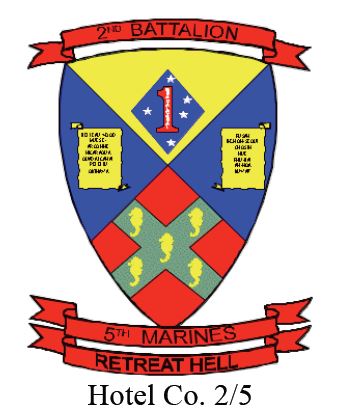The An Hoa base was located approximately 28 km west of Hội An and 4 km west-northwest of the Mỹ Sơn temple complex, near to the Tinh Yen River and the An Hoa industrial complex. The base was first used by the Marines in January 1966 during Operation Mallard when the 1st Battalion, 12th Marines established a firebase there while the 1st Battalion, 3rd Marines, and a Company from the 2nd Battalion, 9th Marines swept the surrounding area. The 5th Marine Regiment of the 1st Marine Division Settled their headquarters in the An Hoa Combat Base. The runway was extended over the years in order to handle larger cargo aircraft.
An Hoa was known as the “Home Base” for most of us in Hotel 2/5 over all the years in Vietnam. It was also sometimes known as the “REAR”. It was a place where we crashed and slept for a night or two before going back out into the Arizona Territory. For many of us in the later years, this was the location we first arrived at when we got assigned to Hotel 2/5.
An Hoa Combat Base was known for these reasons.
- It was a place where the battalion of troops came together.
- It was a base with a runway for cargo planes and helicopters to come and go always bringing troops, supplies, and ammunition.
- It was a base with lots of firepower with the 75mm howitzers and 60/80 mortars.
- The airfield was capable of handling C-7, C-123, and C-130 aircraft.
- Marine PFC Dan Bullock, the youngest American serviceman killed in action in the Vietnam War died at An Hoa on 7 June 1969.
- The 2nd Battalion, 5th Marines handed over the base to the ARVN 1st Battalion, 51st Regiment on 15 October 1970.
It was our base camp where you came when your company needed a few days to rest or if you were slightly hurt or injured, or needed to see a medic or a dentist. We were usually served hot meals here in the local mess hall.
Prior to 1966:
An Hoa was once a French outpost that had a landing strip and some old French buildings and was situated 25 miles south-southwest of Da Nang in the Duc Duc district of Quang Nam Province. The French had come to the An Hoa Basin to extract coal from its southwestern edge at Nong Son. Iron ore and clay were also ripe for exploitation.
In 1962 Diem set up a strategic hamlet at An Hoa, Quang Nam Province, Vietnam to work alongside the planned industrial complex which would house a chemical fertilizers plant, a water purification plant, and a hydroelectric project. By 1964 the factory equipment was either sitting in storage in Saigon or was awaiting shipment to the Republic of South Vietnam. The project director and engineer was the French-trained Le Thuc Can. He’d chosen the site for the complex and some construction had already begun.
In late 1964 the Viet Cong blew up the bridge at Phú Lac (6) along with the iron railway Bridge on Go Noi Island. An Hoa was now isolated from the main transport routes. This setback did not stop Can and he had the runway at An Hoa extended from 1,500 feet to 3,000 feet so it could take large transport planes. The ARVN 51st Regiment was sent to protect the An Hoa project.


